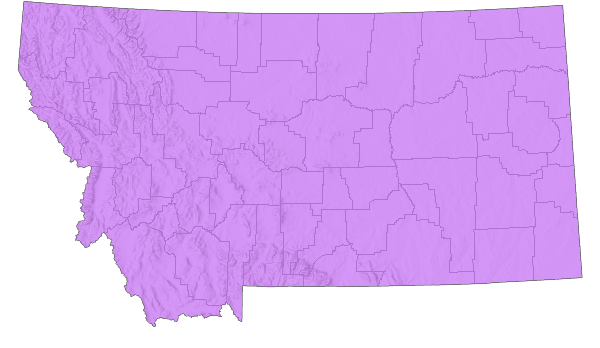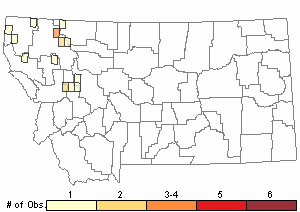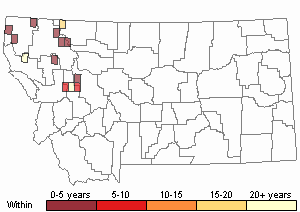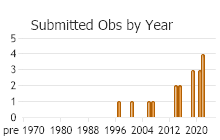View in other NatureServe Network Field Guides
NatureServe
Montana
Utah
Wyoming
Idaho
Wisconsin
British Columbia
South Carolina
Yukon
California
New York
Compton Tortoiseshell - Nymphalis l-album
Native Species
Global Rank:
G5
State Rank:
S5
Agency Status
USFWS:
USFS:
BLM:
External Links
General Description
[From Ferris and Brown 1981, Scott 1986, Glassberg 2001, Guppy and Shepard 2001, Pyle 2002) Forewing 3.3-3.6 cm. The largest of our true nymphs. Wings broad and irregular in outline; inner margin of forewing straight (not curved); dorsal surface rich rusty with large submarginal yellow spots and heavily blotched with large black spots, single white spots on costal margins of forewings and hindwings; ventral surfaces shades of brown, gray and tan, striated and dotted, darker on inner half and white-frosted on outer half, hindwing with central small silver comma mark.
Phenology
One flight; mid-July to early August, the adults hibernate then emerge in spring (April and May) and lay eggs (Scott 1986); early March to mid-October in Oregon and Washington (Pyle 2002), with peaks in April and August reflecting the flights of old and new females, respectively.
Diagnostic Characteristics
The single white spots on costal margins of forewings and hindwings, and ventral hindwing with central small silver comma mark distinguish this species from the similar California Tortoiseshell (Nymphalis californica) and other tortoiseshells as well as the smaller anglewings (Polygonia).
Species Range
Montana Range
Range Descriptions

 Native
Native
Range Comments
In North America, resident from Alaska panhandle and northern British Columbia south to northern Washington, Idaho, and northwestern Montana, east across boreal Canada and northeastern US to the Atlantic Coast. During outbreak years may occur far south and north of the normal range, including to central Colorado, across the northern Great Plains and into the Arctic (Scott 1986, Guppy and Shepard 2001). In Montana, resident in the northwest, possibly resident in the Greater Yellowstone Ecosystem, with scattered records in the eastern plains (Kohler 1980, Debinski 1993, Stanford and Opler 1993, Debinski and Pritchard 2002).
Observations in Montana Natural Heritage Program Database
Number of Observations: 18
(Click on the following maps and charts to see full sized version)
Map Help and Descriptions
Relative Density

Recency



 (Observations spanning multiple months or years are excluded from time charts)
(Observations spanning multiple months or years are excluded from time charts)
Migration
Migratory, with periodic outbreak years when large numbers occur outside the normal range (Scott 1986, Glassberg 2001, Guppy and Shepard 2001, James and Nunnallee 2011).
Habitat
Deciduous woodlands, riparian woodlands, moist canyons, boreal woodland clearings (including logging roads) (Scott 1986, Guppy and Shepard 2001, Pyle 2002). In Glacier National Park, reported from mesic meadows and woodlands (Debinski 1993).
Food Habits
Larval food plants include birches (Betula), elm (Ulmus), willow (Salix) and aspen (Populus); possibly also Humulus and Malus. Adults feed on sap, rotting fruit, mud, and occasionally flower nectar (Ferris and Brown 1981, Scott 1986, Guppy and Shepard 2001, Pyle 2002, James and Nunnallee 2011).
Reproductive Characteristics
Adult females probably begin laying shortly after emergence from hibernation, in April and May. Eggs laid on lower branches of host plant near tip with green unopened leaf buds; eggs laid in clusters of up to 36 eggs. Larval development occupies about 35 days (depending on temperature), with 4, 5, 4, 5, and 17 days spent in L1-L5 instars, respectively. No nests or shelters constructed but larvae are gregarious. Adults emerge from pupae (eclose) in about 16 days (James and Nunnallee 2011).
References
- Literature Cited AboveLegend:
 View Online Publication
View Online Publication Debinski, D. 1993. Butterflies of Glacier National Park, Montana. Occasional Papers of the Museum of Natural History, the University of Kansas, Lawrence, Kansas. No. 159: 1-13.
Debinski, D. 1993. Butterflies of Glacier National Park, Montana. Occasional Papers of the Museum of Natural History, the University of Kansas, Lawrence, Kansas. No. 159: 1-13. Debinski, D.M. and J.A. Pritchard. 2002. A field guide to the butterflies of the Greater Yellowstone Ecosystem. Lanham, MD: Roberts Rinehart Publishers. 107 p.
Debinski, D.M. and J.A. Pritchard. 2002. A field guide to the butterflies of the Greater Yellowstone Ecosystem. Lanham, MD: Roberts Rinehart Publishers. 107 p. Ferris, C.D. and F.M. Brown (eds). 1981. Butterflies of the Rocky Mountains. Univ. of Oklahoma Press. Norman. 442 pp.
Ferris, C.D. and F.M. Brown (eds). 1981. Butterflies of the Rocky Mountains. Univ. of Oklahoma Press. Norman. 442 pp. Glassberg, J. 2001. Butterflies through Binoculars: A Field Guide to the Butterflies of Western North America. Oxford University Press.
Glassberg, J. 2001. Butterflies through Binoculars: A Field Guide to the Butterflies of Western North America. Oxford University Press. Guppy, C.S. and J.H. Shepard. 2001. Butterflies of British Columbia: including western Alberta, southern Yukon, the Alaska Panhandle, Washington, northern Oregon, northern Idaho, northwestern Montana. UBC Press (Vancouver, BC) and Royal British Columbia Museum (Victoria, BC). 414 pp.
Guppy, C.S. and J.H. Shepard. 2001. Butterflies of British Columbia: including western Alberta, southern Yukon, the Alaska Panhandle, Washington, northern Oregon, northern Idaho, northwestern Montana. UBC Press (Vancouver, BC) and Royal British Columbia Museum (Victoria, BC). 414 pp. James, D.G. and D. Nunnallee. 2011. Life histories of Cascadia butterflies. Corvallis, OR: Oregon State University Press. 447 p.
James, D.G. and D. Nunnallee. 2011. Life histories of Cascadia butterflies. Corvallis, OR: Oregon State University Press. 447 p. Kohler, S. 1980. Checklist of Montana Butterflies (Rhopalocera). Journal of the Lepidopterists' Society 34(1): 1-19.
Kohler, S. 1980. Checklist of Montana Butterflies (Rhopalocera). Journal of the Lepidopterists' Society 34(1): 1-19. Pyle, R.M. 2002. The butterflies of Cascadia: a field guide to all the species of Washington, Oregon, and surrounding territories. Seattle Audubon Society, Seattle, Washington. 420 pp.
Pyle, R.M. 2002. The butterflies of Cascadia: a field guide to all the species of Washington, Oregon, and surrounding territories. Seattle Audubon Society, Seattle, Washington. 420 pp. Scott, J.A. 1986. The butterflies of North America: a natural history and field guide. Stanford University Press, Stanford, California.
Scott, J.A. 1986. The butterflies of North America: a natural history and field guide. Stanford University Press, Stanford, California. Stanford, R.E. and P.A. Opler. 1993. Atlas of western USA butterflies: including adjacent parts of Canada and Mexico. Unpubl. Report. Denver and Fort Collins, Colorado 275 pp.
Stanford, R.E. and P.A. Opler. 1993. Atlas of western USA butterflies: including adjacent parts of Canada and Mexico. Unpubl. Report. Denver and Fort Collins, Colorado 275 pp.
- Additional ReferencesLegend:
 View Online Publication
View Online Publication
Do you know of a citation we're missing? Allen, T.J., J.P. Brock, and J. Glassberg. 2005. Caterpillars in the field and garden: a field guide to the butterfly caterpillars of North America. Oxford University Press.
Allen, T.J., J.P. Brock, and J. Glassberg. 2005. Caterpillars in the field and garden: a field guide to the butterfly caterpillars of North America. Oxford University Press. Brock, J.P. and K. Kaufman. 2003. Kaufman Field Guide to Butterflies of North America. Houghton Mifflin Company, New York, NY 284 pp.
Brock, J.P. and K. Kaufman. 2003. Kaufman Field Guide to Butterflies of North America. Houghton Mifflin Company, New York, NY 284 pp. Layberry, R.A., P.W. Hall, and J.D. LaFontaine. 1998. The Butterflies of Canada. University of Toronto Press. 280 pp. + color plates.
Layberry, R.A., P.W. Hall, and J.D. LaFontaine. 1998. The Butterflies of Canada. University of Toronto Press. 280 pp. + color plates.
- Web Search Engines for Articles on "Compton Tortoiseshell"
- Additional Sources of Information Related to "Insects"





